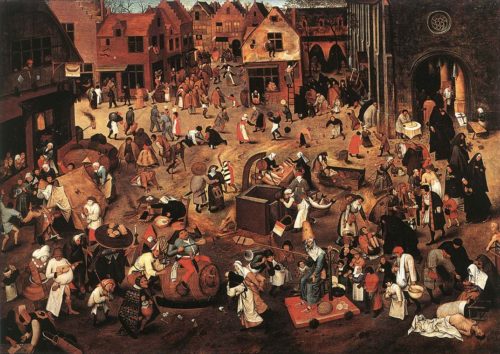
The four types of Dark Age are the Age of Poverty, the Age of Violence, the Age of Ignorance, and the Age of Cowardice. There can be more than one of these ages occurring at any one time, and there can be none, but the invariable is that people suffer in a Dark Age for reasons outside of themselves. These four ages also correspond closely to the four masculine elements of clay, iron, silver and gold.
Humanity seems to have been cast into a world in which all four Dark Ages were in operation simultaneously and when we were little more than animals. One by one, we rose out of these Dark Ages and into a Golden Age, but most would argue that we have since degenerated again.
The Dark Age corresponding to the element of clay is the Age of Poverty. This is when people are unhappy because the basic necessities are hard to come by. A famine would be the typical example of an Age of Poverty, as would a depression. The natural state of humanity in the biological past – i.e. as some kind of ape-thing – could be described as an Age of Poverty.
In an Age of Poverty, children suffer from hunger and basic disease, clothing and housing is shabby and falling apart and getting through every day is a question of making the right sacrifices. There is no surplus, and everything keeps getting harder.
Corresponding to the element of iron is the Age of Violence. The obvious example of this is a war, where people are actively trying to kill each other for whatever reason. In an Age of Violence, people are unhappy because their basic physical security is under threat and this leads to immense anxiety and suffering.
The Ages of Poverty and Violence are related in that the elements that represent them are the two base elements. This suggests that these ages are dark for immediate physical reasons.
The element of silver corresponds to the Age of Ignorance. As silver is brilliant, shines and is reflective, so are those qualities lost in an Age of Ignorance.
Brilliant people become rare; the sort of mind necessary to make original scientific advancements or to produce great works of art, architecture or engineering become impossible to find. No-one shines creatively, instead being possessed of a zombie-like dullness that finds expression in anti-intellectualism and a kind of moronic pride in not reading or being educated.
In a real Age of Ignorance, all aspects of silver are mistaken for signs of either foppishness, passivity and faggotry (from the perspective of iron) or a cruel, detached, insectoid lack of emotional warmth (from the perspective of clay). The real benefits to the quality of life that intelligence brings are either not appreciated or actively despised.
Gold corresponds to an Age of Cowardice. The essence of this age is when men and women lose the Will to confront and to face up to the truth.
That silver and gold are valuable tell us that getting out of an Age of Violence is the most we can expect as a decency. Ages of Ignorance and Ages of Cowardice are ever-present threats owing to the valuable nature of the metaphysical elements that keeps them away.
Generally speaking, human culture devolves from the highest stage down to the lowest, a phenomenon that Plato observed in The Republic. One begins in an aristocracy, which might correspond to an absence of a Dark Age, with the various steps down the ladder of correct rule reflecting a Dark Age corresponding to rule without the next element down. Then comes an Age of Cowardice, when the philosopher kings no longer have the courage to assert their right to rule.
This Age of Cowardice leads to the high-spirited and assertive person taking over, which Plato referred to as a timocracy. This degenerates into an Age of Ignorance, when the rulers ignore the philosophers for so long that the importance of learning and knowledge is forgotten.
Inevitably this leads to poor political decisions being made, which leads to an Age of Violence as the frustration of the people reaches a boiling point. This can either clear out the incorrect rulers and replace them with a new aristocracy of philosopher-kings, or destroy all semblance of civilisation and return humanity to a truly primitive state – the Age of Poverty.

I propose we get real; no single solution/human can solve all the problems themselves. Instead, let’s exploit the unique potential of the best everywhere, to fix what the dark ages have laid before us all. We can. We shall. I see Nu Hope for mankind.